Temporary Desert Structures
Notes about building for Burning Man and other Projects, by Bob Stahl
Also see: Rebar & Rigging FAQ | Field Manuals | DPW
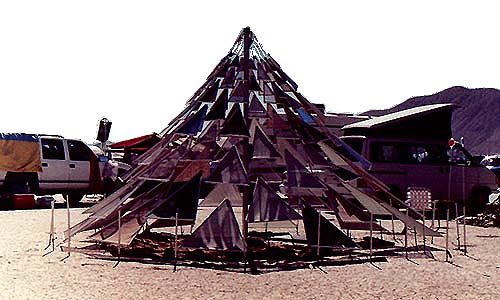
About This Document
Desert camping is the art of applying simple concepts to achieve elaborate results.
These pages were written to give users, notably campers and artists trekking to the Black Rock Desert, and the Burning Man art festival, a few hints on how to build shelters and structures for the extreme heat, severe windstorms, and sudden rains of northwestern Nevada.
It is not intented to give specific structural or safety advice, just an overview of typical methods. If you are uncertain how to proceed, please consult a carpenter, rigger, architect, or engineer. Your camps and installations are your own responsibility.
This document is free for public/personal use, but copyrights apply.
About Burning Man
Burning Man (www.burningman.com) is a temporary art community, created in the Black Rock Desert of northwestern Nevada. An experiment in radical self-expression, it is held the week up to and including the Labor Day (US) holiday, starting at the end of August. Participants must bring all necessities for survival, including water, food and shelter. The land where the event is held is in the Black Rock - High Rock National Conservation Area (NCA)administered by the Bureau of Land Management of the US Department of the Interior. Washoe County, Pershing County, and the State of Nevada also have jurisdiction in the area. Please respect local, state and federal laws, respect the rights of local residents and other visitors, and tread lightly on the desert, leaving no trace when you depart.
The notice printed on recent event tickets says a lot about the event:
You must bring enough food, water, shelter and first aid to survive one week in a harsh desert environment. Commercial vending, firearms, fireworks, rockets and all other explosives prohibited. You agree to read and abide by ALL rules in the Survival Guide. You agree to follow federal, state, and local laws. This is a LEAVE NO TRACE, Pack it in, Pack it OUT event. You are asked to contribute 2 hours of playa cleanup before departure. Commercial use of images taken at Burning Man is prohibited without the prior written consent of Burning Man. You appoint Burning Man as your representative to take actions necessary to protect your intellectual property or privacy rights, recognizing that Burning Man has no obligation to take any action whatsoever.
Info: http://www.burningman.com/ or 415-TO-FLAME
Desert Storms
 Poorly secured tents, structures and loose objects can fall on people or blow miles away. Black Rock Desert summer temperatures can range from the 30s to 100s (F). Afternoon wind speeds range up to 30 mph, and may gust to over 70 mph. Thunderstorms and whiteouts (blinding dust storms) can spring up unpredictably, and may last for hours or days.
Poorly secured tents, structures and loose objects can fall on people or blow miles away. Black Rock Desert summer temperatures can range from the 30s to 100s (F). Afternoon wind speeds range up to 30 mph, and may gust to over 70 mph. Thunderstorms and whiteouts (blinding dust storms) can spring up unpredictably, and may last for hours or days.
Typical weather cycles in August and September may consist of a few very hot, relatively still days, punctuated by another few days with strong winds lasting from noon until dark. A light rain every few days is common. Heavy rains lasting a day or more are not common, but have occurred during Burning Man in 1995 and 1998. Winds strong enough to knock down poorly-secured structures have occurred every year the event has been held.
Basics
Where can you get ideas for simple, safe temporary structures? Try playgrounds, construction sites, circuses, state fairs, flea markets, farms, store awnings, greenhouses, summer camps, and parades. Historical architectural texts can help with clues for the finished look, but tend to stress monumental construction in masonry, steel or concrete. Books on nomadic cultures, or cultures in which wood and other lightweight materials were common, might be more useful for concepts appropriate for temporary desert structures.
Visualization and brainstorming with friends is always helpful, using sketches, cardboard and matchstick models, glued dowels, Tinker Toys, or Legos. When you have a large model or prototype, try it out at the beach or in a wide-open windy place. Untested do-it-yourself structures often reveal unanticipated problems in real-world conditions.
If you are uncertain how to proceed, consult a carpenter, rigger, architect, or engineer. Commercial structures and materials usually come with instructions on suitable uses, so please read the literature and labeling that came with it.
Check the library or new/used book stores for introductory books on architecture. A few good books:
- "Building Construction Illustrated," by Francis Ching, on basic plan drawing.
- "Why Buildings Fall Down," by Levy and Salvadori, on classic disasters.
- "The Way Things Work," by David Macauley, illustrates common machines.
The Building Materials section lists and links to sources of online construction manuals, including basic rigging and carpentry.
Physical stresses on structures may be caused by
- wind gusts from any direction
- people climbing during or after construction
- accumulation of rain water or
- the structure's own weight.
Redundancy is a good design principal -- multiple connections and bracing can prevent total collapse. Two guy lines are better than one. Four stakes better than two.
Structures need to resist sliding and toppling. The base of structures, legs, walls, and guy lines should be staked or embedded in the ground.
Think of a card table. The table top by itself is well-braced in its own plane. Fine. Now, lean on it. If the legs are weak, or poorly attached, or don't stick to the floor, the table may move around too much or collapse. So, each face of the structure should have adequate bracing of some sort, and the whole mass should be well-attached to the ground. Now, imagine your card table in a hurricane with a pack of angry badgers scrambling on it.
Structural Styles
Geodesics
 Geodesic structures -- domes and other "space frames" -- can be built using standard plumbing pipe or electrical conduit (PVC, ABS, aluminum, or galvanized steel); lumber; tree limbs; and heavy bamboo. Connections can be made using loops of rope or bolts; welded, bolted, bent, and/or riveted tubing; hubcabs; plywood; or rope lashing. Geodesic face material can be sheet aluminum, solid plywood, painted cardboard, or rigid insulation. Coverings can be shade cloth, parachutes, tarps, seamed-to-fit cloth, or cloth off the roll.
Geodesic structures -- domes and other "space frames" -- can be built using standard plumbing pipe or electrical conduit (PVC, ABS, aluminum, or galvanized steel); lumber; tree limbs; and heavy bamboo. Connections can be made using loops of rope or bolts; welded, bolted, bent, and/or riveted tubing; hubcabs; plywood; or rope lashing. Geodesic face material can be sheet aluminum, solid plywood, painted cardboard, or rigid insulation. Coverings can be shade cloth, parachutes, tarps, seamed-to-fit cloth, or cloth off the roll.
As an example, geodesic domes up to about 30 feet in diameter, framed with bolted-together flattened-end 3/4-inch steel conduit struts, seem to survive the open desert conditions adequately, if the edges of the frame are secured to the ground, and the covering is taut. Because conduit is sold in nominal 10-foot lengths, a calculated strut length of five feet would seem to be economical, but a few inches must usually be subtracted to allow for flattening and drilling. Is 4.5 feet a good calculated length? It depends on whether the dome is intended to be climbable, like the Thunderdome (see below), and whether the covering is solid or transparent to the wind. A rule of thumb might be to cut a piece of frame material to the proposed strut length, and try to lean on and bend the strut. If it buckles, a shorter length might be better.
Geodesic structures:
- Buckminster Fuller Institute promotes Fuller's philosophies and design explorations. Among their "Books & Resources" links is an online version of his book Synergetics, which starts with this profound definition: "A structure is a self-stabilizing energy-event complex."
- Shelter Publications is a source for the classic large-format book Shelter by Lloyd Kahn (1973), an overview of do-it-yourself domes, huts, tents, yurts, sheds and other vernacular architecture from the 1970s back to ancient times.
- Desert Domes has Javascript strut-length calculators for domes of 1v to 6v complexity, and lots of practical info for designing and erecting steel conduit domes. Tara Landry was the designer of the dome used as part of Burning Man base structure in 2004, and has many useful links on her site.
- Geometry Camp - Steve Lerner & friends developed an easy geodesic shade structure at Burning Man c. 1997-99 -- a simple icosahedron made with 25 ten-foot lengths of 1-1/2 or 2 in. PVC, connected using 1/4 in. rope laced through 3/8 in. drilled holes, diameter 18 ft, height 14 ft.
- Pacific Domes in Oregon has been producing steel conduit domes and covers since 1980. They were the maker of Death Guild's 44-foot-diameter open-frame Thunderdome, which is able to support a number of climbers, including two battle participants hanging from slings and swinging foam weapons. Note that this dome was originally 3/4 in. conduit, as are most Pacific Dome's sizes, but was upgraded to 1 in. conduit.
- Geodesic Dome Design by Michael J. Gourlay.
- A Rainproof Geodesic Dome for Burning Man by Tamara Munzner.
- Integratron.
- Desert Nose is an irregular geodesic literally modeled after Buckminster Fuller.
- Spiky
- Cardboard Domes.
- Stromberg's produces the Starplate steel frame connector for building geodesics using standard 2x2, 2x3 or 2x4 lumber.
- Shelter Systems produces geometric shelters with PVC pipe frames.
- BiniSystems produces unusual structures which unfold and inflate.
- The Pod produces modular icosahedron dome kits.
Geodesic mathematics & models:
- George Hart
- Geometry Junkyard
- V Bulatov
- Zvi Har�El
- Mathematica MathWorld solid geometry, polyhedra, Johnson solids, etc.
- Drexel Math Forum polyhedra
- Exploratorium geodesic gumdrop & toothpick models
- Gijs Korthals Altes paper models of polyhedra
- Zometool modeling kits
- Desert Domes
- Michael J. Gourlay
- David Anderson's Monkey House
Tensegrity
Tensegrity structures developed by Kenneth Snelson and Buckminster Fuller use compression members to provide rigidity, held in mid-air by tension wires or ropes. Daredevil Dan has played with tensegrity shade and sculpture; he suggests another tensegrity website for info on simple structures using many sections of pipe and spools of rope.
PVC Pipe Domes
Domes made with lengths of hoop-shaped PVC pipes have become popular for shade structures because of the ease with which plastic pipe can be cut, joined, transported, and assembled. This structural idiom has long been used by nomadic peoples, who would arch flexible branches to form a dome and cover it with hide or weavings.
These domes gain stability by weaving long, arched PVC pipes in an inverted bowl shape. Firmly staking the ends of each pipe length to the ground creates a bowed arch. Lacing a number of arched pipes together in a circular plan using rope lashings or bungie cords creates a stable dome, if you have enough of the pipes crossing such that you create a network of 3- to 6-foot triangles. Typical nominal PVC pipe size for a strong, moderate sized dome (20- to 30-foot dia.) are 1-1/2" for primary members, and 1" for bracing members; minimum grade, Schedule 40, although some people go with lighter irrigation pipe. Some camps at Burning Man have gone to 2" pipe for larger domes.
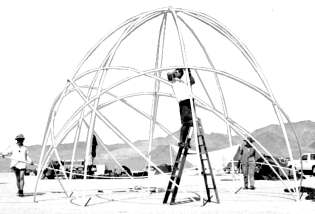 PVC domes can be dimensioned such that parachutes will readily conform to the hemispherical shape. Camouflage netting is even more conformable, and will not catch the wind as much, but will not shed a light rain. Polypropylene shade cloth, which typically comes six feet wide, can be laced over a PVC dome and attached with ties.
PVC domes can be dimensioned such that parachutes will readily conform to the hemispherical shape. Camouflage netting is even more conformable, and will not catch the wind as much, but will not shed a light rain. Polypropylene shade cloth, which typically comes six feet wide, can be laced over a PVC dome and attached with ties.
The Cultural Worker's Union of Santa Cruz is one camp that has been building and improving their dome design since 1996. Improvements made in 1998 included the addition of a reinforcing center ring (photo above and info from Aaron Ferrucci & Jeremy Lutes). The Space Lounge group designed single domes for Checkpoint Salon and the Earth Guardians, and a more free-form PVC pipe dome structure for Media Mecca in 1998; since then they have used geodesic domes.
PVC pipe is a great material for portable structures if its limitations are recognized. It has low strength; brittleness; and is prone to deterioration from exposure to sunlight over time. It typically comes in white or gray, but orange, blue, and purple conduit can be found at plumbing and electrical suppliers. Common sizes can be bought anywhere; it's as maleable and versatile as TinkerToys or popsicle sticks; very lightweight; and easy to cut and drill with hand tools.
Camp Siestah's plan used a parachute strung from a single pole (LeeDogg's site is inaccessible, unfortunately), resulting in a cone or wide teepee shape rather than a dome. A central 3-inch PVC pipe pole was the only rigid support, from which twenty guy lines spoke out to 48-inch capped steel stakes arrayed in a circle equal in size to the diameter of the parachute (the pole length is equal to half the nominal diameter of the parachute, plus one or two feet for burial).
Also see Argyre Patras' parachute plan for another simple setup, which uses a PVC pipe hoop around the parachute perimeter.
Tensile Structures
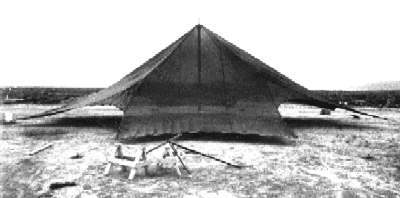 Unlike PVC domes, upon which the fabric covering can be limply draped and not affect the structural stability or final shape, the fabric in true tensile structures is an integral part of the structural assemblage. Tensile structures are critically dependent on very strong anchorages to stretch the membrane tightly, and on very strong conformable material which flexes to take compound-curved shapes. Most modern backpacking tents are tensile structures, as are smaller commercial tensile structures for camping are available from companies such as Eureka (also see Tents, below). REI in the SF Bay Area now has a small tensile tarp-tents designed for lightweight camping; one looks a cute three-legged bug. Bruno Postle has an extensive list of links to tensile structure design firms, manufacturers of large fabric-covered structures, and software for designing tents and tensile structures. "J�rg Schlaich is responsible for some of the most cutting-edge designs in space structures. The Rudi Enos site has some fantastic stuff. The Burning Man DPW assembled a Tensile Structure prototype in 1999, pictured above. We're still working out the kinks. If you know of someone who has succeeded with designing large, original, affordable tensile structures for desert conditions, please let us know.
Unlike PVC domes, upon which the fabric covering can be limply draped and not affect the structural stability or final shape, the fabric in true tensile structures is an integral part of the structural assemblage. Tensile structures are critically dependent on very strong anchorages to stretch the membrane tightly, and on very strong conformable material which flexes to take compound-curved shapes. Most modern backpacking tents are tensile structures, as are smaller commercial tensile structures for camping are available from companies such as Eureka (also see Tents, below). REI in the SF Bay Area now has a small tensile tarp-tents designed for lightweight camping; one looks a cute three-legged bug. Bruno Postle has an extensive list of links to tensile structure design firms, manufacturers of large fabric-covered structures, and software for designing tents and tensile structures. "J�rg Schlaich is responsible for some of the most cutting-edge designs in space structures. The Rudi Enos site has some fantastic stuff. The Burning Man DPW assembled a Tensile Structure prototype in 1999, pictured above. We're still working out the kinks. If you know of someone who has succeeded with designing large, original, affordable tensile structures for desert conditions, please let us know.
Tents, Tarps, Awnings, and Other Fabrications
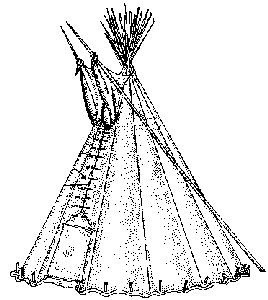 A broad range of tents, shade structures, basic shelter, and tent-like structures don't immediately fit into other categories. Typical raw materials are listed in the Building Materials section.
A broad range of tents, shade structures, basic shelter, and tent-like structures don't immediately fit into other categories. Typical raw materials are listed in the Building Materials section.
- La Rificolona, built for Burning Man in 2001 by Daniel Watts and friends, used canvas, bamboo, and steel to make a giant folding lantern-like tent structure
- Clif Cox' quonset-hut style tunnel shelter made with blue tarp and PVC
- Oregon Country Fair Embassy mega-quonset-hut style tunnel shelter made with silver tarp and PVC
- Camp Tiedown inspired by Moroccan tents
- Camouflage for Desert Operations - US Army Field Manual 90-3
- Central Asian nomads
- Bedouin nomads of Syria
- Reliable tipis
- Nomadics tipis
- Edward S. Curtis photographed tipis in their original context
- Laubin and Laubin, "The Indian Tipi: Its History, Construction, and Use"
- the Society for Creative Anachronism fancies authentic medieval tents, costume, and attitude
- also see Medieval Pavilions
- Shelters Unlimited Bedouin tents
- Tentsmiths makes an unbelievable variety of period tents: nomadic, Viking, medieval, military, and expedition; nice sketches.
- The manufacture of wooden tent pegs was once a thriving rural industry, fueled by war, that has passed into relative obscurity along with broom making and charcoal burning
The amazing Ammonite tent/sculpture, a spiral shaped tent made of white synthetic cloth stretched over aluminum hoops, was installed by artist Hendrik H. Hackl at Hualapai Playa in 1997. The artist has also shown the sculpture in the Sahara Desert. The sculpture had an overall diameter of more than 60 feet.
Tents and fabric shelters can be bought, rented, made at home, made on-site, or made to order. My favorite for personal use is a family-style canvas square-bottom safari tent. Around the tent I erect a windbreak fence, like a corral, to create a sheltered space for coolers and other gear. This keeps the occasional cold all-night winds away from the tent door, too.
Most off-the-shelf styles of tents and awnings, because they are not usually designed for extreme conditions, risk being flattened in a big wind. Poles can bend to the point of breaking, weak fabric, grommet points, and seams can rip open, and openings that catch a breeze may cause the tent to float or fly away. Dome tents are the simplest sleeping tents to pitch, very sturdy, and probably better than most in big wind. Search under "tent rentals" at Yahoo to see what's available in very large tents. Check sporting goods and surplus stores for smaller tents and shelters. Used tents can be very economical; check the Yellow Pages under used sporting goods.
Many tents have anchor points midway-up on the sides; use them. Solutions for wind resistance include pitching tents within a circle of vehicles, other tents, and/or structures. I've found that raising a windbreak even two or three feet high around a single tent can shield it very effectively. A windbreak could consist of a narrow strip of tarps, fabric, or plywood, supported by stakes or fenceposts.
Tents require tie-downs or guy lines to long stakes at every corner and major guy line. Awnings, large kitchen and assembly tents can be reinforced by driving tee-shaped steel fence posts next to the poles and wrapping with wire or rope. Guy lines can be tied off to screw anchors, fence posts, or stakes. It's best to substitute longer steel stakes (at least 18" to 24" for small tents and at least 30" for larger tents), or screw anchors as appropriate, for the typically short stakes that come with most tents. The Building Materials section has more info on stakes.
Kit awnings consisting of blue or silver reinforced plastic tarps stretched over a steel conduit framework. Common at farmer's and flea markets, they are advertised in home-improvement magazines, and are available from some surplus and sporting goods stores. Tarps perform best stretched tight as a drum, sloping only slightly so they can shed rain water. Chef Juke recommends Ed Bradley heavy-duty canopies; Dragon recommends Higgins Enterprises. Cheap vinyl tarps can be found at tool and lumber places such as Harbor Freight Tools.
High-tech lightweight shade awnings include the potato-chip-shaped "Wing" shelters by Moss Tents, available at G & M Sales in San Francisco. Kelty markets similar awnings; check with REI or your local sporting goods store.
The sections on the Black Rock City Center Camp and shade crew show how Burning Man has been trying to construct economical, fail-safe shade for public areas.
Kites
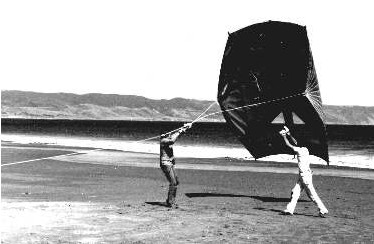 Larnie Fox built a bamboo and fabric kite/sculpture for Burning Man 1996, and a windmill in 1997.
Larnie Fox built a bamboo and fabric kite/sculpture for Burning Man 1996, and a windmill in 1997.
Kite-making is perhaps the best object lesson in learning how to keep something from blowing apart in a high wind. If the broad face of an object in the wind can't resist, or yield, or turn away from the wind like a luffing sail, it may rupture or put a fatal stress on the structure. Too-rigid connections and seams along a flexible fabric may also break apart. Think about how the relative flexibility of of individual elements is going to affect the overall strength of a structure under heavy loads, such as a high wind. Or people jumping on it. Check out kite sites from:
- Belgium
- Australia
- New Zealand
- the Netherlands
- Germany - lots of plans, and a history of kites
- Britain - big list of worldwide links
- Japan - monstrously huge, elegantly painted kites
- America - designs for Cody bat-wing kites as large as 33 feet
- Charles Benton - kite aerial photography
- Michael Brown - kite aerial photography
- how to use a melting ice cube as a shutter triggering mechanism
- Harald Prinzler - kite aerial photography
- Great Usenet newsgroup -- rec.kites -- kites, kite buggies, kite surfing
- Steve Irby sails around in Nevada
The photo shows a 14-foot "Scott sled" kite designed and built by myself and the Tomales Bay Explorers Club, made from clear polyethylene sheeting reinforced with vinyl pipe-wrap tape (which stretches with the sheeting), and with 1"x2" wood stretchers, flying at Drake's Beach. David Bunnett painted a rendition of the Mount St. Helens eruption on the kite. For anchoring the line, we used a 1-1/2" steel pipe frame, bolted to two sheets of 3/4" CDX plywood, buried two feet in the beach sand as a dead-man, and wrapped the 3/8" nylon kite rope around the pipe (photo by Laura Leek).
As a rule of thumb, kites and inflatables at Burning Man should be on lines no longer than about 500 feet, or 1000 feet with notification of the Rangers. Take care and be ready to warn people nearby if your flying object suddenly becomes a crashing object. Watch out for emergency helicopter flights and low planes, and fly only in the airspace over the open playa, not over camp. Lawn-chair balloonists are advised to carry life insurance.
Inflatable Art
 Spiral Oasis made very effective assemblages of plastic tubing in 1997. The pieces were about two feet in diameter and at least forty feet long, and filled with hot air, which is rather abundant in the Black Rock desert. They launched a big black triangle of tubing, which soared over camp and flew quickly from Hualapai Playa to parts east. They also brought a sixty-foot Vertitube Man. Both of these must not have weighed more than twenty pounds each. Air Dimensional Design makes these air tubes. (Photo by Bruno Randolf.) Tim Kaulen's 1997 Sta-Puft Lady was an inflatable 20-foot-tall figure made from discarded advertising signage (detail).
Spiral Oasis made very effective assemblages of plastic tubing in 1997. The pieces were about two feet in diameter and at least forty feet long, and filled with hot air, which is rather abundant in the Black Rock desert. They launched a big black triangle of tubing, which soared over camp and flew quickly from Hualapai Playa to parts east. They also brought a sixty-foot Vertitube Man. Both of these must not have weighed more than twenty pounds each. Air Dimensional Design makes these air tubes. (Photo by Bruno Randolf.) Tim Kaulen's 1997 Sta-Puft Lady was an inflatable 20-foot-tall figure made from discarded advertising signage (detail).
Polyethylene sheeting is available by the roll in hardware stores, and plumbing supply outlets have black polyethylene pipe sleeves in 10-ft to 20-ft tear-off lengths, used by underground contractors use to protect pipelines from corrosion. These could be used to make free-form inflatable assemblages, and seamed by heat welding, stapling, using light wood battens, or by sewing between fabric seam reinforcement strips with a wide stitch.
Latex weather balloons have been used at Burning Man to buoy parachute shade covers, and to lift remotely-operated cameras. Aaron Ferrucci lifted a camera over the Man via weather balloon in 1996. See the last paragraph of the section on kites for operating guidelines.
This Russian site on fluid dynamics of textile structures shows how designers can optimize the shape, fabric selection, webbing, and other aspects of parachutes and inflatables; go the "Gallery" to see computed shapes.
Mud
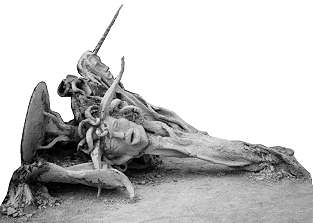 Pepe Ozan and his minions in Tower Camp have been constructing absolutely beautiful, curvaceous, sculptural adobe towers -- the Fire Lingams -- as set pieces for dramatic performances of the Burning Man Opera for a number of years. The primary skeleton consists of rebar, stiff wire, and wood. The framework is draped with chicken wire or expanded metal lath which is cut, bent, tied and welded to delineate the surface. This is covered with a relatively thin mud mixture obtained from a local source. The towers are temporarily guyed off to the ground until the mud becomes hard. Hollow spaces in the towers are stoked with wood and flammable brush, and torched at the close of the opera. Find out more from:
Pepe Ozan and his minions in Tower Camp have been constructing absolutely beautiful, curvaceous, sculptural adobe towers -- the Fire Lingams -- as set pieces for dramatic performances of the Burning Man Opera for a number of years. The primary skeleton consists of rebar, stiff wire, and wood. The framework is draped with chicken wire or expanded metal lath which is cut, bent, tied and welded to delineate the surface. This is covered with a relatively thin mud mixture obtained from a local source. The towers are temporarily guyed off to the ground until the mud becomes hard. Hollow spaces in the towers are stoked with wood and flammable brush, and torched at the close of the opera. Find out more from:
- the Burning Man Opera website
- one of the producers
- the Burning Man website (volunteer here)
Other artists have succeeded in getting sanction from Burning Man for collecting mud for reasonably-sized sculptures, but excavating great quantities of the ancient playa is not really in keeping with the long-standing "Leave No Trace" policy and BLM regulations.
Siege Engines, Rockets, Pyro, Art Cars, & Mobile Art
The highly dangerous activities illustrated at the Catapult Museum, Radical and Extreme Hobbies, Skylighter, Inc., and Woodpussy sites are presented for amusement purposes only. Please don't kill anyone. Extremely large, hazardous, movable objects will be dealt with on a case-by-case basis by the Burning Man organization.
One example of a large mobile object completely inappropriate for Burning Man is the giant land yacht built onsite in 1998 and untested until some yahoo took it for a spin in a sandstorm, wrecking it against the Opera fire lingams. As a result, sail vehicles are virtually banned at Burning Man. Since 1996, when tragic accidents occurred due to reckless driving, the maximum speed limit in the public spaces in Black Rock City has been set at 5 mph (no dust trail). The Black Rock Rangers have a "DMV" (Department of Mutant Vehicles) specifically mandated to discourage reckless vehicle operation. The Black Rock Desert is home to many fun, high-speed activities at other times of year, such as challenges to the land speed record, and land sailer races, but this isn't compatible with the pedestrian traffic at Burning Man. On July Fourth you can see kite buggies or land sailers in the free open spaces (search the Internet for the "Holy Gale" event). Mobile chairs, couches, beds, and entire living rooms are okay at Burning Man if they are operated safely.
Art Cars have been a presence at Burning Man from the beginning, and the found-art esthetic of Art Cars can be seen in camp structures and other creations decorated with baby-doll heads, spray-foam shapes, toys, anything that can be attached with hot-melt glue or duct tape, and lots of silver spray paint. "Traditional" Art Cars are usually street-legal and so are relatively safe, although whiplash is a hazard with rubber-neckers.
Mobile processional artworks have been produced by Burning Man -- the Nebulous Entity (1998) and Bone Tree (1999) -- and by groups such as the Mystic Krewe of Satyrs from New Orleans. Parades are always a group effort, and a tradition that goes back thousands of years. Media used in processional art have included papier mache over light wire mesh (chicken wire), lath made from thin plywood, spray foam, newspaper bundled in plastic pallet wrapping (e.g. the Nebulous Entity), bones on a steel frame (e.g. the Bone Tree), canvas, and combinations of other lightweight material.
Other large mobile art has include Robert Burke's mysterious moving lighthouse in 1999, and his rusty rebar buffalo in 1998, both built on top of salvaged cars. Jim Mason's Veg-O-Matic of the Apocalypse, a giant medieval-looking tricycle built for four, shoots a forty-foot flame.
Towers, Buildings, and Metal Art
 The Chapel of the Burning Book, an ambitious artwork executed to awe-inspiring effect by the Shasta Mountain Playhouse in 1998, was a 20-foot cubical structure with a central dome, with an opening in the front for a raised stage. The skin was clad in multi-colored translucent recycled plastic, shredded and attached by heat-welding and silicon caulk to stiffened steel mesh panels. Backlit at night, the plastic had the effect of stained glass. Figure mosaics, framed like Gothic arch windows in steel, were done by artist Finley Fryer. The interior supporting frame was standard steel scaffolding.
The Chapel of the Burning Book, an ambitious artwork executed to awe-inspiring effect by the Shasta Mountain Playhouse in 1998, was a 20-foot cubical structure with a central dome, with an opening in the front for a raised stage. The skin was clad in multi-colored translucent recycled plastic, shredded and attached by heat-welding and silicon caulk to stiffened steel mesh panels. Backlit at night, the plastic had the effect of stained glass. Figure mosaics, framed like Gothic arch windows in steel, were done by artist Finley Fryer. The interior supporting frame was standard steel scaffolding.
Scaffold
Scaffold makes for a quickly assembled framework for tall structures. On standard steel scaffolding, the end frames pin together, but usually need additional "redundant" ties to keep the pieces from disassembling when rocked by high winds. All connections on aluminum scaffolding should be checked and additional ties added, as appropriate. Each pin should be bolted through, or tied with heavy wire. Cross-braces can be tied on with rebar tie wire or something similar, in addition to the bolts or pins. Steel tee-shaped fenceposts, driven into the ground and wired onto the scaffold legs, can help pin the structure in place. Plywood pads at least one inch thick and 12 inches square should be put under the feet of the scaffold. Guy cables or ropes should be splayed off at about 45 degrees and cinched to stakes or screw anchors. Typically, each level above the second level should be guyed to the ground.
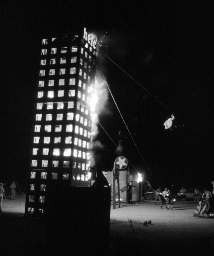 Helco -- the supra-national conglomerate that, it is said, tried and failed to buy out Burning Man in 1996. The name strikes different chords in the the collective memory, and brings the scent of brimstone to the nostril. This project by the Seemen and associates included a 40+ foot tall wood-frame tower, with plywood walls perforated with square windows. The ignition of the tower by John Law, who climbed to the top and escaped by fly rig, was true grit theater. Flynn Mauthe, who constructs staging and set pieces for Survival Research Laboratories, built this tower and currently supervises much of the building for Burning Man (photo source - grfx.com).
Helco -- the supra-national conglomerate that, it is said, tried and failed to buy out Burning Man in 1996. The name strikes different chords in the the collective memory, and brings the scent of brimstone to the nostril. This project by the Seemen and associates included a 40+ foot tall wood-frame tower, with plywood walls perforated with square windows. The ignition of the tower by John Law, who climbed to the top and escaped by fly rig, was true grit theater. Flynn Mauthe, who constructs staging and set pieces for Survival Research Laboratories, built this tower and currently supervises much of the building for Burning Man (photo source - grfx.com).
Towers
Towers of wood, scaffolding, or prefabricated metal frames must be guyed to the ground, unless sufficient staking can be done at the base to prevent toppling. Many large metal artworks have been raised at Burning Man. As with scaffold or towers, it becomes pretty obvious when guy lines or other supports are needed. Large open frames are most vulnerable to weak members, faulty welds, or bad connections. People can and will climb on anything that is accessible to climbing, which may add a lot more load than anticipated.
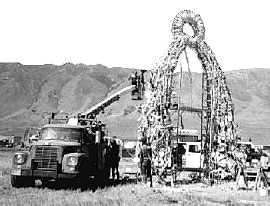 Michael Christian attached desert-bleached horse and cow bones to a welcoming gate structure, with a steel rebar frame, in 1997 (photo at right). As shown, boom trucks and scaffolding sometimes aid in the erection of taller structures. Artists should check with the Project, or other artists, about availability, but it's a good idea to at least bring a ladder.
Michael Christian attached desert-bleached horse and cow bones to a welcoming gate structure, with a steel rebar frame, in 1997 (photo at right). As shown, boom trucks and scaffolding sometimes aid in the erection of taller structures. Artists should check with the Project, or other artists, about availability, but it's a good idea to at least bring a ladder.
Commercial radio towers are available from Rohn (309) 697-4400; serious rigging and guying hardware is available from Carpenter Rigging in San Francisco (phone 800-40-SLING), Feeney Wire Rope & Rigging in Oakland, and McMaster in Los Angeles.
The Man and Other Wood Structures
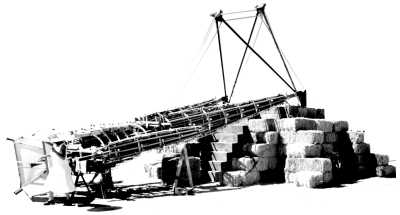 Wood is easy to work with and burns relatively cleanly, which is a great inducement for its frequent use at Burning Man.
Wood is easy to work with and burns relatively cleanly, which is a great inducement for its frequent use at Burning Man.
The Burning Man itself was originally designed and built by Larry Harvey and Jerry James for the first Burn on Baker Beach in San Francisco in 1986. Dan Miller, Chris Campbell, Dale Scott, and Dave Carr later became responsible for the Man building, and have made design refinements over the years.
The basic conventions of carpentry and architecture should be used to build anything out of wood, keeping in mind that you will not have a concrete foundation for anchorage against wind forces. As with tents, liberal use of long steel stakes and screw anchors is advised. Plywood gussets, attached with construction adhesive and nails or screws, work well to brace wood lumber frames. Screws are not my favorite joining method for anything critically structural; nails are less brittle when shearing forces are applied. Double-headed "duplex" nails are easy to drive and remove. However, most of the Burning Man elements are joined with screws.
The unusual, enigmatic, and elegant nature of the Burning Man design attracted the attention of Fine Woodworking Magazine a couple of years ago, in an article about Chris Campbell. Structurally, the Man has a bolted, heavy lumber frame, 2x and 1x bones and tendons and jigsaw-cut elliptical plywood skin elements. The very open framework allows the wind to permeate and puts less stress on the structure and guylines.
The original Man was eight feet tall, but the height has been 40 feet since 1989. The Man was built in Gerlach for the first time in 2001, by many of the same guild of carpenters who have built it for a number of years. Custom steel fittings for bracing and seating the Man were fabricated by DPW's metal shop crew. The pedestal is built by a DPW carpentry crew. Steel cables attached to the shoulders and to screw-in anchors at the ground level are used as guy lines.
Until this year, the Man was hinged at the feet, and was raised and lowered using heavy rope and a large crew of people called up from all around the camp. Steel A-frames were used to gain mechanical advantage while the Man was at a shallow angle to the ground during raising and lowering. The Man was raised and lowered a number of times to attach paraffin-soaked burlap, neon tubing, pyrotechnics, and wiring for the lighting and pyro.
Through the year 1995, the Man was stood on the ground. The Man was placed on a 10-foot-high wood pedestal in 1996, which was increased in height to about 14 feet in 2000. In 2001 the pedestal was about 30 feet tall. The Man was placed by the rigging crew using a crane, and was fixed in place rather than hinged at the base. The burlap was tied on while the Man was on the ground, and neon and pyro were attached in the air using snorkel-lifts. Over the years, the Man has been raised to a greater height to allow greater visibility during both the duration of the event and the burn. This has coincided with the increasing size and population of Black Rock City, and the increasing size of theme camp structures and other art installations.
Straw bales were used to make a stepped pyramid surrounding the wood platform from 1996 to 2001. Straw bales have been placed with other pyro material inside the pedestal to aid the burn. In 2001 a broader-based pyramidal wood platform was built to a height of 30 feet, with interior ladders and viewing platforms.
Burn scar prevention presented itself as a critical issue in 1999; other cleanup issues included preventing problems associated with straw and burn debris. In 2000 and 2001, fire resistant silica fabric was placed on the ground under the platform, and covered with a two-inch layer of screened decomposed granite sand trucked in from a quarry in Sparks. Sand, rather than a metal platform, was chosen as the primary fireproof material for appearance and to prevent foot injuries. The purpose of silica cloth is to provide physical separation between the sand and the playa surface.
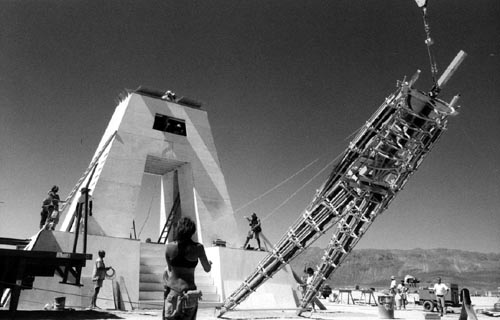
The 30-foot pedestal in 2001 was designed by Larry Harvey, city designer Rod Garret, and construction manager Russ Leslie. This new departure makes the pedestal itself an architectural feature of the Man as an art installation. The size of the footprint of pedestal was somewhat defined by the amount of fireproof silica fabric Burning Man had purchased in 2000, but the overall configuration was the product of architectural and artistic decisions made by the designers. They wanted to raise the height of the pedestal at a steep angle for greater visibility, less of a squat appearance, and to conserve building materials. The resulting appearance as an "A"-shape was somewhat unintentionally, because a tall, tapered structure pierced by one or more openings simply gives that appearance. The design references traditional Japanese gates, which also have a calligraphic aspect.
Fixing the Man in place presents a much more stable situation for rigging the neon and pyro, in the wake of multiple rigging and wiring problems in previous years. Some of the problems have resulted from racking and breakage during raising and lowering, and damage from rogue participants attempting to climb the Man. The esthetics and accessibility of the pedestal were much-discussed throughout the year 2001. The pedestal was incorporated as part of the "Seven Ages" theme art as the "Temple of Wisdom". The intention was to give access to the interior and upper levels to people participating in a theme-camp-like passport system. As I did not participate in this or pay much attention to themes in general, I cannot give any first-hand information or opinions. I thought the pedestal looked fine. Another source of complaints in 2001 was reduced participation in raising and lowering the Man. While I sympathize with the people who miss helping out with this during the event, I hope people realize that we now have the opportunity to prevent most of the screw-ups that have made past burns a highly unsafe, frantic situation for the neon, pyro, fire prevention, fire performance, and perimeter crews. Many people contribute to this effort, and volunteer help is more than welcome. I'm guessing that the increased height and amount of burning material probably contributed to initiating the amazing dust devils rising and falling off the Man during the burn. In any case, it was a happy consequence of the presence of a lot of dust, favorable atmospheric conditions, and a big fire.
Burning Art & Leaving No Trace
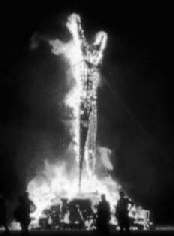 Planning to burn a large installation? For Burning Man, check on burn scar prevention and creating dangerous art safely. Contact the pyro crew before the event and notify the Rangers.
Planning to burn a large installation? For Burning Man, check on burn scar prevention and creating dangerous art safely. Contact the pyro crew before the event and notify the Rangers.
Burning Man participants should check with their art installation people on current burn scar prevention guidelines. Community burn spots with fire-proof mats are provided. The Man and major stationary art burns have thick mats of sand and fireproof cloth underneath. Various combinations of steel sheeting, fireproof fabric, sand, brick, and other materials are used.
Artists and participants planning large burns should take initiative and plan their burns to reduce the amount of ashes and debris contacting the playa soil. Scrap steel sheeting, with sand, seems to be the cheapest workable solution. Used brick is another possibility. Raising the sheeting a few inches above the soil surface can provide a cooling air space. A layer of sand on the playa can supply a critical insulating layer, and sand on top of the steel sheeting absorbs the products of combustion. Check local metal scrap or recycling yards or the building materials section of the classified ads.
 The progress of burning will remove different structural supports in succession. Predicting the collapse of the structure is part of defining an appropriate crowd perimeter. The Man is designed such that the heavier skeletal supports stay attached to steel guy lines, while the multitude of smaller pieces are consumed in flame. Ideally, by the time the main timber supports are largely compromised by combustion, most of the medium-weight pieces still hang as well, still giving a stick-figure shape to the Man. Then, a few robust jerks on the guy lines will bring the Man down in a heap, rather than toppling over into the crowd closing in on the Burn.
The progress of burning will remove different structural supports in succession. Predicting the collapse of the structure is part of defining an appropriate crowd perimeter. The Man is designed such that the heavier skeletal supports stay attached to steel guy lines, while the multitude of smaller pieces are consumed in flame. Ideally, by the time the main timber supports are largely compromised by combustion, most of the medium-weight pieces still hang as well, still giving a stick-figure shape to the Man. Then, a few robust jerks on the guy lines will bring the Man down in a heap, rather than toppling over into the crowd closing in on the Burn.
Charles Gadeken, of the Illumination Village project, shows how to burn a 200 foot canvas, a giant head, and a Trojan cockroach. Elevating an object to be burned, like one of Charlie's giant canvases, virtually eliminates the possibility of creating a burn scar.
Leave No Trace -- pull all stakes, pack up all materials, bag your trash and ashes, put it in your truck, fill all your holes, and leave the playa as smooth and clean as you found it. Otherwise, you're leaving your mess for volunteer cleanup crews. See these cleanup photos from 1998 and 1999 (Credit: BookBill, D.S. Black, Burning Man).
Black Rock City - Center Camp
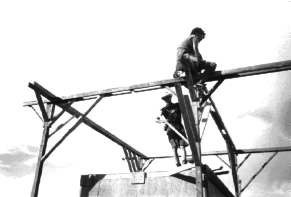 The 1997 and 1998 Center Camp Cafe shade structures presented a unique challenge to build -- reconciling budgets, personalities, time, number of helpers available, and safety. The 1997 Cafe was about 50 feet square; the 1998 Cafe was about 80 feet in diameter. In both years my concept was to provide a heavy anchorage on the more windward, western side of the layout, so as to brace the structure against the more prevailing winds; for this, we used the Cafe storage shed. This scheme seemed to work even when violent windstorms kicked up from the northeast.
The 1997 and 1998 Center Camp Cafe shade structures presented a unique challenge to build -- reconciling budgets, personalities, time, number of helpers available, and safety. The 1997 Cafe was about 50 feet square; the 1998 Cafe was about 80 feet in diameter. In both years my concept was to provide a heavy anchorage on the more windward, western side of the layout, so as to brace the structure against the more prevailing winds; for this, we used the Cafe storage shed. This scheme seemed to work even when violent windstorms kicked up from the northeast.
The 1997 Cafe structure was built similar to a garden trellis or porte-cochere, with the bases of all posts firmly staked to the ground and the overhead structure heavily knee-braced. The 1998 Cafe structure consisted of inner and outer rings of steel scaffolding, staked at the base, with guy cables run to the ground diagonally from the corners.
The fabric covering of the 1997 Cafe was originally planned to be new patio shade cloth similar to that sold at Home Depot and other outlets. Budget constraints forced a switch to an old nylon 60-foot parachute. Because the (round) parachute did not conform well to the (flat) trellis, the parachute could not be properly battened, and blew to shreds. We repaired the covering with rented mesh tarps from Star Staging in Reno.
 Learning from this in 1998, we were able to securely batten the ends of our 80-foot lengths of 18-foot-wide synthetic cloth between 2"x4" by 20-foot boards, which were in turn roped down to the scaffolding. A few intermediate battens nailed down to the scaffolding, and ropes slings over the top, kept the cloth from billowing. The cloth used was a type of road stabilization fabric (geotextile) available from masonry and heavy construction supply yards (Mirafi 500X, 600X or 700X). So, we learned that although we had no problem designing a very strong, perhaps over-engineered structural frame, light cloth coverings should be as taut as possible and controlled along all edges.
Learning from this in 1998, we were able to securely batten the ends of our 80-foot lengths of 18-foot-wide synthetic cloth between 2"x4" by 20-foot boards, which were in turn roped down to the scaffolding. A few intermediate battens nailed down to the scaffolding, and ropes slings over the top, kept the cloth from billowing. The cloth used was a type of road stabilization fabric (geotextile) available from masonry and heavy construction supply yards (Mirafi 500X, 600X or 700X). So, we learned that although we had no problem designing a very strong, perhaps over-engineered structural frame, light cloth coverings should be as taut as possible and controlled along all edges.
We got a lot of help during Cafe construction from the crew at Pedal Camp and the many volunteers who showed up at Center Camp and offered assistance. You rock!
Black Rock City - DPW Shade Crew

The 1999 crew led by Peter Mars developed a quick and easy method of building shade structures for various Burning Man installations, and raised many more square feet of shade than the Project had in years previous. These were made in the post-and-beam style, with 4"x4" posts embedded two to three feet into the ground, 2"x6" beams bolted to the posts seven to eight feet above the ground, and 2"x4" diagonal braces. Black synthetic cloth was stretched tightly across the frame and fastened with screwed-on battens. The cloth was the same road stabilization fabric used for the 1998 Center Camp Cafe. A number of configurations have been built, including a two-story tower and lean-to awnings built against trailers.
Art, Style, & History
Encyclopedias, texts on stage scenery construction, books on ancient civilizations, Dover publications, and architectural references are good sources for building styles. The Great Buildings website has models of famous world architecture.
The nomads of the desert regions stretching from West Africa to Mongolia over centuries have developed portable architecture that probably best suits the Black Rock Desert. The Bedouin black wool tent, called by these people a house of hair, sheds wind better than any structure, and it provides deep shade and insulation from the wide temperature variations of the desert. These are truly the original tensile structures. The dome-shaped tents of laced branches used along the southern reaches of the African desert bear a resemblance to the Native American wickiups as well as PVC pipe domes constructed by many Burning Man participants. Check the links in the section on tents and try to find books such as "African Nomadic Architecture," by Labelle Prussin, and "Tents - Architecture of the Nomads," by Torvald Faegre. Something of note is that tent architecture and the culture of their everyday use is alomst entirely a concern of the women among the nomads, from the preparation of goat-hair cloth to the raising of the tents, as the men are devoted to the tending and trading of camels and goats.
The Roman Colosseum is an example of an ancient amphitheater or stadium which, in the summer, would be covered with a velarium, an enormous canvas shade suspended from the rim.
For inspiration, a list of artists in no particular context:
- Christo and Jeanne-Claude have realized many large-scale environmental artworks, such as Running Fence, installed in Marin County, California, in 1976, and The Umbrellas, installed along the "Grapevine" section of Interstate Highway 5 in California in 1991. Their works involve months to years of presenting proposals, discussing the plans with the public and regulators, obtaining permits and materials, and hiring staff and contractors to build the projects; however, all the work is paid for by the artists, from the sale of preparatory drawings. The Running Fence was 24 miles long, 18 feet high, used two million square feet of white nylon fabric, 2050 steel poles (21 feet long 3-1/2-in. dia.), embedded 3 feet in the ground, 90 miles of steel-cable guy wires, 14,000 earth anchors, and 2050 fabric panels secured to upper and lower cables by 350,000 hooks
- Michael Heizer - city - the man has a bulldozer and he's going to use it
- Walter de Maria - Lightning Field in remote New Mexico
- Isamu Noguchi - the soul of zen
- Robert Smithson - Spiral Jetty in the Great Salt Lake
- Claes Oldenburg - hand me that icebag, it was a rough night
- Jean Tinguely and Niki de Saint-Phale - Stravinsky Fountain, Centre Pompidou, Paris - the fountain looks quite jolly and whimsical, but in the Sixties, Saint-Phale did performance art paintings titled Tir a Volont� (Fire at Will) with darts, pistol, or rifle, shooting balloons filled with paint on canvases or assemblages, one of which was titled Portrait of My Lover ; she explained, "I shot because it was fun and made me feel great. I shot because I was fascinated watching the painting bleed and die. I shot for that moment of magic. It was a moment of scorpionic truth. White purity. Sacrifice. Ready. Aim. Fire. Red, yellow, blue -- the painting is crying, the painting is dead. I have killed the painting. It is reborn. War with no victims." Tinguely made automatic drawing machines in the same period, handing out leaflets throughout Paris that invited the public to "Do it yourself and create your own abstract painting with Tinguely's m�ta-matics"
Solar, Wind Power, Lighting, & Electronics
The Alternative Energy Zone group collects and distributes information on portable solar and wind power systems at Burning Man. They have been organizing a generator-free camping collective, and have a mailing list for discussing green power technology and the Zone.
Gas generators should be chosen which have enough power to suit the needs of your equipment. Saws are usually the biggest power draw -- consider lower-amp tools such as jig-saws or 6-inch circular saws, rather than 15-amp worm-drive saws. Battery drills and saws are the easiest to adapt to alternative power. Power tools I find useful to bring to the desert are a small chain saw, 9-volt and 12-volt drills, a 14-volt saber saw, and a 12-volt 3-inch circular saw. I also bring hand drills, such as a bit brace, with which you can easily drill holes up to one inch or more; hand saws, such as a regular cross-cut saw, a hack saw, and a pruning saw; and a Yankee screwdriver. I've used a rudimentary solar setup to recharge single drill batteries, but will be looking forward to setting up a bigger charging unit.
Low-power neon-like colored lighting using electro-luminescent wire is available from auto stores specializing in do-it-yourself custom alterations for import cars and low-riders; also check out PlayaFish - Funhouse Productions, elwire.com, Glowire, Kriana Krill Lights. Low-rider magazines, Radio Shack, outdoor stores, hardware stores, and big computer/electronics stores are possible sources for these, 12-volt blacklights, LED lights, MagLites, strobe lights, and all kinda cherry kewl stuff. The L2K Circumference Project around the Man in 2000 used LED lights. Solar, twelve-volt area lighting, and electronics sources include Real Goods, Fry's Electronics, boating/marine supply outlets, and some large hardware stores. Twelve-volt DC area lighting systems for gardens and landscaping are sold in major hardware outlets.
Any suggestions for this section? Let me know.
Building Materials and Basic Data
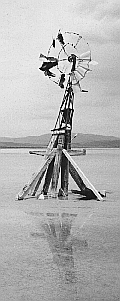 The following are estimates. Your mileage may vary. Sorry, I can't help you with trigonometry, statics, or wind tunnel tests. Wear gloves and eye protection when appropriate.
The following are estimates. Your mileage may vary. Sorry, I can't help you with trigonometry, statics, or wind tunnel tests. Wear gloves and eye protection when appropriate.
- Natural forces. Wind pressure on structures can exert at least 25 pounds per square foot pressure over the gross area; gusts and extremely high winds can more than double this estimated pressure. Water pooling on concave surfaces, and people climbing onto structures, can add unexpected weight. Frictional resistance of an object resting on the playa is approximately the weight multiplied by a factor of about 0.2.
- Stakes and anchors. The forces stakes and anchors can resist depend on how deeply they can be driven, the firmness of the playa, and angle to the load. Shallow stakes will pull out easily on a very wet playa.
- Stake and guy line safety. Foot injuries and tire punctures can be avoided by burying the top of the stake slightly below the ground surface. Dig a little dirt from around the top of the stake to attach guy lines, then rebury it. Protruding stakes, even if capped or bent over, can still present tripping or puncture hazards; stakes and guy lines should be made safe for passers-by with some sort of protection and highly visible flagging. Steel is rough on the hands, wood has splinters, and rope can burn, so try to wear gloves when handling, and safety glasses when hammering.
- Capping stakes. Tops of stakes can be capped with tennis balls, heavy plastic bottles, short sections of plastic pipe, wads of duct tape, baby-doll heads, baby-doll bodies, bowling balls, old tires, drilled wood blocks, or the ideal cappers, the orange plastic caps made for concrete form stakes, which cost about 50 cents at larger hardware stores.
- Steel stakes. Round, 3/4" steel stakes used for concrete form work come in a variety of lengths up to four feet. Driven three feet into the ground these may hold a couple of hundred pounds, applied at an oblique angle. Wider, stronger stakes, such as car axles, steel pipes, or fence posts, may hold between a few hundred pounds and a ton. Multiple stakes can be used in tandem in a number of different configurations (see the Army rigging manual, below, for some ideas). Metal stakes be cut using a hack saw, saber saw, abrasive disk, rebar cutter, large bolt cutters, or oxy-acetylene torch.
- Rebar stakes. Rebar (ribbed steel bar used in reinforced concrete) is pretty cheap, or free if you find can find scrap pieces in dumpsters or at construction sites.
- Wood stakes. Useful for pinning the base of plywood flats, boxes, and poles. Can be cut 24" to 48" long, from 2"x2" to 2"x4" lumber, and pointed at a 45 degree or sharper angle at the base. Holding power is dependent on size, depth, tightness in the hole, wetness of the playa. Once started through the hard playa crust, they can be pounded in with a sledge hammer up to about two feet deep.
- Size and number. Single 3/8" or 1/2" steel stakes, at least 24" long, are usually sufficient for small tents or structures. For larger tents and structures, longer and thicker steel (5/8" or thicker, at least 36" long) is better. Screw anchors, 3/4" steel form stakes (36" to 48" long), tee-stake fence posts, heavy pipe, wood stakes, and car axles are preferable to rebar. Two smaller stakes can be driven in one spot, crossing each other, for greater holding power. Multiple stakes can be driven in a row, directly in line with the guy line, and tied off to each other.

- Fence posts. Tee-shaped steel fence posts can be driven next to poles or posts for extra support, and wrapped to the poles with wire or rope. This can help improve inexpensive store-bought patio shade awnings. Bring a sledge hammer or use a fencepost driver.
- Anchors. Screw-in ground anchors (shown on the pallet in the graphic) are available at lumber yards or hardware outlets that cater to tree trimmers or vineyards. A standard size anchor, with a 3-1/2" to 4" diameter helix, and is about 40" long, can hold about a ton in a very firm playa. Screw them in with a cheater bar of 3/4" steel pipe, or a 3/4" steel stake.
- Removing stakes. The top of rebar or round steel stakes can be gripped with vise-grips cross-wise to the stake, twisted or rotated a few times, rapped on the side with a hammer, and then pulled straight out quite easily.
- Stake and guy line safety. Foot injuries and tire punctures can be avoided by burying the top of the stake slightly below the ground surface. Dig a little dirt from around the top of the stake to attach guy lines, then rebury it. Protruding stakes, even if capped or bent over, can still present tripping or puncture hazards; stakes and guy lines should be made safe for passers-by with some sort of protection and highly visible flagging. Steel is rough on the hands, wood has splinters, and rope can burn, so try to wear gloves when handling, and safety glasses when hammering.
- Bamboo. Larnie Fox has built bamboo kites and windmills at Burning Man. For local sources, see American Bamboo Society, BJones' list of sites, and Bamboo Bridge in Benicia, California. A Google search under "bamboo" and "scaffold" will turn up many sites showing the tall temporary access scaffolding used in the construction of highrise buildings in Asia. But cracking in the dryness of the desert would severely compromise the strength of bamboo for major structures.
- Metal pipe. Pipe to be used for structural members should be chosen with care. Conduit usually refers to thin-walled metal tubing (EMT) used for electrical wiring. This is used in geodesic dome frames, for which three to five feet is the typical strut length, and 3/4" the typical minimum strut diameter. Steel plumbing pipe is much heavier and stronger for a given pipe diameter than conduit. Threaded connections cannot resist much bending, and failure can be sudden. I have used special scaffolding connectors to make frames out of 1-1/2" pipe, but stopped using this system at Burning Man because all the heavy pipe and fittings wore out my truck springs. Schedule 40 or better PVC can be used for tents, domes, or flagpoles, but shouldn't be used to support people. Wood, aluminum, or steel pole supports for large structures need to be chosen and designed by experienced carpenters, riggers, or design professionals, as appropriate.
- Plastic pipe. Relatively lightweight; easy to cut; turns brittle after a couple of seasons exposed to UV radiation outdoors; care must be taken to protect the ends from bending or shattering; Schedule 40 or better PVC is best.
- Rope. One never has enough rope. Cheapest by the spool, or 50 to 100 foot lengths. Poly truck rope is the cheapest useful rope, but hemp rope is better for lashing poles together. Try to size rope for the intended loads. 3/8" to 1/2" are usually good for moderately sized structures. The most useful knots are the clove hitch, two half hitches, taut-line hitch, bowline, cat's head, and sheet bend. Learn a trucker's hitch, too, for cinching loads and for guy lines. For knot instructions, try Boy Scout or nautical books, or see the US Army Rigging manual, Roper's Knot Page, Knots on the Web or my knot page
- Guy lines and rigging. Fiber rope, or steel "wire rope", can be used for heavy-duty guy lines. Check the allowable strength for the intended loads. Wire rope can be cut with cable cutters, special wire-rope cutters, a chisel and anvil, or a welding torch. Loops and splices in wire rope should be secured with two or three (never just one) properly sized cable clamps ("Crosby" clamps) at each end. One manufacturer's site has a few illustrations of guying hardware. Very lightweight objects and small tents can be guyed with bungee cord (elastic shock cord), pre-made or by-the-foot. Searching at Yahoo under "rigging" will turn up dozens of useful links. See the US Army Rigging manual.
- Tarps and fabric coverings. Shade structure profiles should be kept as horizontal and low to the ground as possible. Widely-spaced grommets in off-the-shelf tarps may rip out; more closely-spaced grommets can easily be added using kits available at hardware or surplus stores. Tarp ends can be sandwiched between wood battens. Store awnings are examples of tightly-stretched wind-resistant tarps. Canvas, denim, ripstop nylon, and other materials can be used for sewing custom tarps and coverings. Available light tarp and shade materials:
- Shade mesh fabric. Patio and greenhouse shade mesh typically comes six to twelve feet wide. A variety of shade densities and colors are available, generally costing about $0.35 to $0.35/sq ft off the roll, and somewhere between $0.20 and $0.30/sq ft for whole rolls. Available from larger lumber and hardware outlets, and agricultural supply houses. Awning and rigging contractors can provide seaming, grommets or edging for special sizes and shapes.
- Mesh truck tarps. Well-stocked hardware stores such as Jackson's in San Rafael may have very strong black mesh truck tarps edged with grommets that run about $0.60/sq ft. These are used on pickups, gravel trucks and debris boxes. Trucking and rigging supply outlets such as Carpenter Rigging in SF and Feeney Wire Rope in Oakland have similar prices, and they can special-order any size. Trucking supply outlets may be cheaper.
- Road stabilization fabric. Concrete & masonry supply yards such as Shamrock in San Rafael have the strong black woven poly cloth Burning Man has been using for shade lately, either in whole rolls or by the foot. It's called "road stabilization fabric", Mirafi 500X or 600X. There are two widths: 12.5' wide -- 360' long -- $345 (= $0.13/sq ft); 17.5' wide -- 250' long -- $366 (= $0.12/sq ft). They sell either width off the roll at $0.20/sq ft. No edging, no grommets, and it's a very dense weave can catch the wind on vertical profiles.
- Parachutes, camo netting, and sails. Surplus stores have silk, nylon, and cotton parachutes, and camouflage netting, for about $0.50/sq ft. Check every inch of the parachute before you buy it to check for rips or rotten fabric. Used sails make very strong, often colorful, water resistant tarps, available from sail-making shops for about $0.40 to $1.00/sq ft; search online at Yahoo under "used sails".
- Shade mesh fabric. Patio and greenhouse shade mesh typically comes six to twelve feet wide. A variety of shade densities and colors are available, generally costing about $0.35 to $0.35/sq ft off the roll, and somewhere between $0.20 and $0.30/sq ft for whole rolls. Available from larger lumber and hardware outlets, and agricultural supply houses. Awning and rigging contractors can provide seaming, grommets or edging for special sizes and shapes.
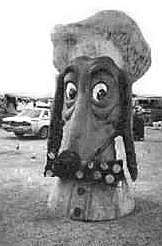 Plastic zip ties. A little inadequate for securing large tarps in strong winds, or almost anything except very light shade cloth or electrical wiring. Wire or rope is usually better. Zip ties can be used only once, then must be cut loose with a knife or wire cutter. They have become a serious litter problem during cleanup.
Plastic zip ties. A little inadequate for securing large tarps in strong winds, or almost anything except very light shade cloth or electrical wiring. Wire or rope is usually better. Zip ties can be used only once, then must be cut loose with a knife or wire cutter. They have become a serious litter problem during cleanup.
- Wire. Rebar tie wire is good stuff for basic use and emergencies. Double it for redundancy. Unbarbed twisted fence wire is a heavier wire, good for tieing poles or scaffolding off to stakes.
- Fiberglass. The Doggie Diner chef is fiberglass, as was the site-built mold for the Temporal Decomposition ice ball in 1997. The Southern California Timing Association members have been racing streamlined creations, many of them with fiberglass shells, on the El Mirage dry lake for over fifty years. Just don't try to burn fiberglass, please, it's very noxious.
- Duct tape. Insidious, overrated, sticky, tears easily in some cases, but it's absolutely essential. One thing I use it for is wrapping exposed tie wire, to protect the skin of passersby. Vinyl electrical tape, and "pipe wrap" tape, which is similar, are handy as well.
- Recycling. It's amazing what you can build out of junk recycled from dumpsters, construction sites, warehouse debris boxes, or junkyards. Be careful of structural defects, and pipes that may have carried waste.
Experiment
Prototype your structure in an open field, parking lot, or beach on a windy day.
Where Can I Get Stuff?
The local hardware store won't have everything you need for a desert foray. Check under these typical phone directory categories:
- Army & Navy Goods
- Building Materials
- Canvas Products
- Contractors' Equipment
- Cargo & Freight Containers
- Fabrics
- Fence Materials
- Hardware
- Hoisting & Rigging Equipment
- Lumber
- Pipe
- Scaffolding
- Ship Chandlers
- Steel
- Surplus Merchandise
- Tarps
- Tree Service Equipment & Supplies
- Vineyard Products & Supplies
- Welding
- Wreckers
Phil Stripling's Civilized Explorer website has a very extensive catalog of information, including outlets for typical Burning Man paraphernalia, from glow sticks to robot kits.
Here's some Reno/Sparks and other useful outlets (no endorsement intended):
Hardware, Lumber - Reno/Sparks
B & C Builders Supply Company, 543 Overmyer Road, Sparks, NV 89431, (775) 359-7373
Eveleth Lumber Company, 802 East 4th Street, Reno, NV 89512, (775) 323-4156
Home Depot, 6590 South Virginia Street, Reno, NV 89511, (775) 851-9600
Home Depot, 2955 Northtowne Lane, Reno, NV 89512, (775) 674-2900
Logan Lumber Company, 2272 Larkin Circle, Sparks, NV 89431, (775) 359-7300
Lowes, 2450 Oddie Boulevard, Sparks, NV 89431, (775) 356-6333
Lowes, 5075 Kietzke Lane, Reno, NV 89511, (775) 824-4750
Lumberjack Building Materials, 1299 Baring Boulevard, Sparks, NV 89434, (775) 356-6005
Lumberjack Building Materials, 12828 South Virginia Street, Reno, NV 89511, (775) 852-3000
North Valleys Hardware, 160 Lemmon Drive, Reno, NV 89506, (775) 677-0155
P & S Hardware, 905 West 5th Street, Reno, NV 89503, (775) 329-1392
Shelly's True Value Hardware, 440 Greenbrae Drive, Sparks, NV 89431, (775) 358-1841
Vaughn Materials Company, 2400 Valley Road, Reno, NV 89512, (775) 323-1381
Western Builders Supply Inc, 601 South 15th Street, Sparks, NV 89431, (775) 358-6868
Rigging - wire rope and hardware; custom waterproof and mesh tarps
Search category "Hoisting & Rigging Equipment" at www.superpages.com or the Yellow Pages (hardware stores have limited selection).
Carpenter Rigging, 222 Napoleon St, San Francisco, CA 94124, (415) 285-0176, (800) 40-SLING
Feeney Wire Rope & Rigging, 2603 Union St., Oakland, CA. 94607, (800) 888-2418, (510) 893-9473
Rohn (309) 697-4400
McMaster-Carr P.O. Box 54960, Los Angeles, CA 90054-0960; plant: 9630 Norwalk Blvd., Santa Fe Springs, CA 90670-2932; (562) 692-5911
International Greenhouse Co. -- price schedule (888) 281-9337
Tarps & Tie-Downs 2288 Tripaldi Way, Hayward, CA 94545, (510) 782-8772
Welding - Reno/Sparks
Sierra Welding Supply, 1300 Glendale Ave, Sparks, NV 89431, (775) 359-4445
Screw-in ground anchors - Search category "Vineyard Products & Supplies" or maybe
"Tree Service Equipment & Supplies" at www.superpages.com or the Yellow Pages
Cameron & Cameron Inc, 1175 River Road, Fulton, CA 95439, (707) 546-7706, (800) 546-7706
(a vineyard supply yard near Santa Rosa.)
Sporting Goods and Surplus - Reno/Sparks - camping gear
Twin City Surplus, 1675 E. 4th St., Reno, NV 89512, (702) 323-5630, (888) 323-5630
Military Surplus - San Francisco Area
G & M Sales Company, 1667 Market Street, San Francisco, CA 94103, (415) 863-2855
Acme Surplus Store, 5159 Mission Street, San Francisco, CA 94112, (415) 586-4343
Best of California Surplus, 1541 Haight Street, San Francisco, CA 94117, (415) 861-0404
Kaplan's Surplus & Sporting, 1055 Market Street, San Francisco, CA 94103, (415) 863-3486
Pioneer Army & Navy Store, 1133 Market Street, San Francisco, CA 94103, (415) 621-8909
Berkeley Surplus, 1640 San Pablo Ave
Berkeley, CA 94702, (510) 524-8434
Marin Outdoors, 935 Andersen Drive, San Rafael, CA 94901, (415) 453-3400
Military Surplus - Sacramento
Auburn Army Navy, 4720 Auburn Boulevard, Sacramento, CA 95841, (916) 485-1120
General Surplus Sales, 1010 El Camino Avenue # AF, Sacramento, CA 95815, (916) 925-3235
Radical Auto Parts
Ace Auto Dismantlers Inc, 2255 McKinnon Avenue, San Francisco, CA 94124, (415) 282-1353
Contacts
The best way to stay informed about Burning Man is to check the home page of the website at www.burningman.com, which has instructions on subscribing to the "Jackrabbit Speaks" email announcement newsletter, links to recent project newsletters, how to get on the paper-based mailing list, volunteer information, links to regional contacts, and more.
The e-playa bulletin board is accessible at the official website and is maintained by Burning Man. There are several regional areas, and topic areas including art, performance, construction, and ride sharing. Anyone can browse; a simple registration process is required before being able to post.
The "burnman-list" is a two-way email list -- an unofficial, very informal online salon and clearinghouse for any and all ideas related to Burning Man -- a way to let playa dust accummulate on your hard drive. The list is not sponsored or operated by Burning Man, but is a volunteer effort by friends of the Blue Light District village. Expect about 5 to 20 messages per day. The list server address is majordomo-at-dioxine.com -- send an email with the text "info burnman-list" to get information about the list. To get on or off the list send a message to this address with "subscribe burnman-list [your email address]" or "unsubscribe burnman-list [your email address]" in the text of your message. There are up to a couple of hundred list subscribers. See Emily Postnews or the Netiquette Home Page for helpful hints on email lists.
Myself
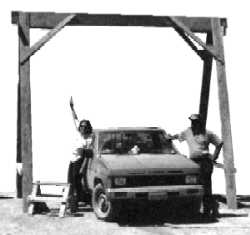 My own background is in carpentry, landscaping, geotechnical engineering, and heavy construction. Karl Beckmann talked me into going to Burning Man the first time in 1996, when we did the "Free Mass Shower". Thanks to Harley Bierman, Will Roger, Flynn Mauthe, and Joegh Bullock for getting me involved in helping build the city in the desert back in 1997. Larry Harvey provides conceptual guidance to the project, and Rod Garrett is the primary architect of the Black Rock City layout, but the thousands of participants and volunteers make the vision happen in its myriad forms. When you get to the desert, feel free to ask around for Bob Stahl -- my nickname/radio handle is BillyBob, and I work with the Black Rock City Department of Public Works -- the DPW. Contents of this page and email responses to questions express opinions only, with no implied warranty. All rights to text or images on this site reserved, but feel free to distribute a link to this page. Thanks for visiting.
My own background is in carpentry, landscaping, geotechnical engineering, and heavy construction. Karl Beckmann talked me into going to Burning Man the first time in 1996, when we did the "Free Mass Shower". Thanks to Harley Bierman, Will Roger, Flynn Mauthe, and Joegh Bullock for getting me involved in helping build the city in the desert back in 1997. Larry Harvey provides conceptual guidance to the project, and Rod Garrett is the primary architect of the Black Rock City layout, but the thousands of participants and volunteers make the vision happen in its myriad forms. When you get to the desert, feel free to ask around for Bob Stahl -- my nickname/radio handle is BillyBob, and I work with the Black Rock City Department of Public Works -- the DPW. Contents of this page and email responses to questions express opinions only, with no implied warranty. All rights to text or images on this site reserved, but feel free to distribute a link to this page. Thanks for visiting.
© Bob Stahl | Home
Last update Feb 16, 2004